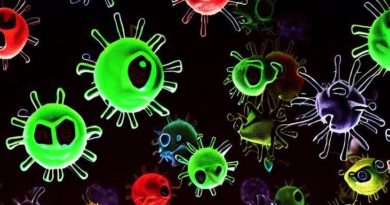Unnatural origins of Covid and its Variants
Guest Post by Paul Craig Roberts
Covid and Its Variants are Laboratory Creations
On September 4, I reported that Japanese scientists had examined Covid and its variants and found that all are Laboratory creations. https://www.paulcraigroberts.org/2023/09/04/japanese-scientists-find-that-covid-19-and-all-of-the-variants-are-laboratory-creations/ This discovery raises the dangerous and disturbing question why a laboratory is producing viruses with which to infect humans.
I contacted a scientist who had been involved in the study of the original SARS for his evaluation and explanation of the Japanese scientists’ report. His explanation is below. It is challenging for non-professionals to follow, but less so than the Japanese study itself. As I understand the findings, it is the absence of synonymous mutations in the variants that reveal that Covid and its variants are lab creations.
I suspect that the Japanese study will be suppressed and that any American or Western scientist who took up this inquiry would find himself cut off from research funds and his career terminated.
Unnatural origins of Covid and its Variants
Marc G. Wathelet, Ph.D.
The origin of SARS-CoV-2, the etiological agent of COVID-19, remains controversial more than 3 years after its identification. Is this virus the product of a natural zoonotic event at a meat market in Wuhan or does it come from a laboratory working on coronaviruses? These two hypotheses are currently unresolved but a recent preprint sheds much light on the issue, and raises some troubling questions.
This preprint “Unnaturalness in the evolution process of the SARS-CoV-2 variants and the possibility of deliberate natural selection” (https://zenodo.org/record/8216373), by Atsushi Tanaka and Takayuki Miyazawa from Osaka Medical and Pharmaceutical University and from Kyoto University, was written for scientists. Here is an attempt at making their findings accessible to a larger audience.
Their analysis of Omicron variants led them to the conclusion that “the formations of a part of Omicron isolates BA.1, BA.1.1, and BA.2 were not the products of genome evolution as is commonly observed in nature.” How did they come to such a startling conclusion? They started their work by analyzing the sequence of the Spike protein from a number of isolates of the virus.
A protein is a chain of amino acids that folds itself into a 3D-structure and it is the sequence of amino acids in that chain and the shape of that structure that determine the biological activity of a protein. In the case of Spike, the main biological activities are binding to a receptor at the cell surface and allowing the fusion of the cell and virion membranes, leading to the entry of viral RNA into the cell.
The sequence of amino acids in a protein is determined by the sequence of the mRNA encoding it. This chain of amino acids is produced by a specialized machinery in our cells, the ribosome, which translates the genetic information contained in the mRNA nucleotide sequence into an amino acid sequence.
There are four nucleotides in an mRNA sequence, A, C, G and U, and there are 20 amino acids in proteins. How do we go from 4 nucleotides to 20 amino acids? Enters the genetic code, elucidated in the early sixties. An mRNA sequence is read in triplets of nucleotides, called codons. Because all 3 positions of a triplet can be any of the 4 nucleotides, there are 4 x 4 x 4 possible codons, thus 64 codons total.
There is some degeneracy in the genetic code, a given amino acid can be encoded by 1, 2, 3, 4 or 6 codons. For instance the amino acid glycine can be encoded by these four codons: GGA, GGC, GGG and GGU, which brings us to a key concept, synonymous and non-synonymous mutations. Genetic sequences naturally varies over time, specific nucleotides change, or are deleted or inserted, these are called mutations relative to the original sequence. RNA viruses in particular are prone to rapid mutations.
When the 3rd nucleotide in a triplet encoding glycine is substituted by any other nucleotide, the amino acid encoded will still be glycine, it is called a synonymous mutation. However if any of the first two nucleotides are modified, the amino acid produced will be a different one, it is thus a non-synonymous mutation. Given the genetic code, a little less than a quarter of random mutations will be synonymous.
When a mutation is synonymous, the amino acid is not changed and thus the activity of the protein is not affected. For non-synonymous mutations, the effect of the changed amino acid can be unfavorable, neutral, or favorable for the function of the protein. Most non-synonymous mutations negatively affect the performance of a protein, because a protein sequence is already the product of a long evolution selecting favorable amino acids.
In the case of a virus, unfavorable mutations are at a disadvantage and quickly eliminated, it is negative selection, while favorable mutations have a competitive advantage over no or neutral mutations. For instance mutations that would increase the affinity of Spike for its cellular receptor are favorable and are positively selected. After this basic molecular biology introduction, we are now in a position to understand the data presented by the Japanese researchers.
They examined 3 Omicron lineages, BA.1, BA1.1 and BA.2. Compared to the original Wuhan strain, BA.1 has 50 amino acids changes, 39 of which were found in Spike, which is a 1,273 amino acid long protein, out of the 14,149 amino acids encoded by the virus. It is expected that more mutations are found in Spike compared to the rest of the genome, because of the constraints against change to maintain function for the replication machinery (11,501 amino acids) and the selective pressure on Spike to better interact with its receptor.
Omicron BA.2, identified less than 2 weeks after BA.1, has 31 amino acids changes compared to the Wuhan strain in Spike, 14 of which are shared with BA.1. Uncannily, these early Omega Spike sequences have a single synonymous mutation and 39 or 31 non-synonymous mutations for the BA.1 and BA.2 lineages, respectively. This ratio of synonymous to non-synonymous mutation is clearly abnormal as ~24% of random mutations are expected to be synonymous and generally there is no selective pressure for or against synonymous mutation.
By contrast, immediate descendants of BA.1, such as BA.1.1, BA.1-0.1, and BA.1-0.2 have 23 synonymous mutations and BA.2-01, the immediate descendant of BA.2, has 21 synonymous mutations, but no new non-synonymous mutations. Synonymous mutations are known to accumulate regularly over time, providing a sort of evolutionary clock, while non-synonymous mutations accumulation is a function of their benefit to the virus replication.
The BA.1 and BA.2 lineages must share a common ancestor given their 14 identical non-synonymous mutations and one synonymous mutation in Spike, and from the time of their divergence, many months must have elapsed in order to accumulate an additional 25 or 17 non-synonymous mutations, respectively. Yet, during that time, some 8-10 months, not a single synonymous mutation occurred in either lineage, which is clearly incompatible with natural evolution and with the observation that their immediate descendants harbored over twenty synonymous mutations in their Spike sequence.
What about the earlier variants? Compared to the original Wuhan strain, the Alpha variant had 10 non-synonymous mutations in Spike, Beta had 10, Gamma had 12, Delta had 11 and Mu had 9, but strikingly none of these variants had any synonymous mutation in Spike. Such observations are unprecedented in the history of natural viral genome evolution.
Back to the Omicron lineages, the researchers probed databases looking for the immediate precursors of BA.1 and BA.2. To do this, they started by reverting one of each changed amino acid back to the original in the Wuhan sequence and used an alignment program to find perfect matches in the databases. According to evolutionary theory, one would expect to find variants where one, two, three and more of the changed amino acids correspond to the original Wuhan sequence.
Such climbing back of the evolutionary tree would identify the path followed from the common ancestor to BA.1 and BA.2, progressively accruing additional changes in their amino acids sequence, but this is not what they observed. Astonishingly, they found 100% matches for 38 of the 39 single reversed amino acids of the BA.1 lineage. Likewise, they found perfect matches for 29 of the 31 reversions found in the BA.2 lineage.
These results could not be more incompatible with evolutionary theory, where we expect the progressive accumulation of changes in amino acids sequences, and not what is observed here, 38 and 29 candidates as immediate precursor of BA.1 and BA.2 lineages, respectively.
It is possible that some of these sequences could be what is known as natural revertants, where a new mutation restores the mutated amino acid back to its original identity. However, such rare reversion events would need an astronomical number of sequences to be probed in order to detect them all, and the limited number of sequences present in databases exclude that possibility.
How do we account for these observations, then? A molecular biologist will recognize this pattern of mutants as that of a classic experiment where the effect of specific mutations is systemically analyzed, one by one. Alternative hypotheses, based on natural evolution, do not come to mind.
The most parsimonious hypothesis to account for the observations reported by Tanaka and Miyazawa is that the Omicron lineage BA.1 and BA.2, as well as all their single amino acid revertants found in databases, are specifically designed and generated laboratory products.
Moreover, the grossly abnormal imbalance between synonymous and non-synonymous mutations found in the Omicron BA.1 and BA.2 lineages is also found in the Alpha, Beta, Gamma, Delta and Mu variants, which each have about 10 non-synonymous mutations but zero synonymous changes in nucleotide sequence. Because the probability of such a mutation pattern is exceedingly low, it is difficult to escape the conclusion that these variants are most likely laboratory creations as well.
The implications of these findings on the origin of SARS-CoV-2 are sure to be profoundly disturbing.
This article has been archived for your research. The original version from The Burning Platform can be found here.



